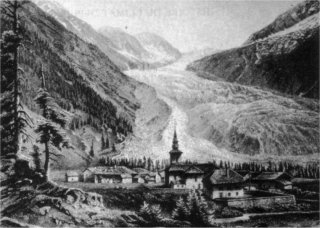
Weather > The Effects of Global Warming on Skiing > Europe's Shrinking Glaciers
Situated way above the small ski resorts that will be most seriously affected by climate change, the glaciers of the Alps are slowly, but surely vanishing. This trend began at the end of the so called little ice age at the start of the 19th century. A point that also coincided with the start of the industrial age and the burning of large amounts of fossil fuels. Since then the glaciers have lost between 30 to 40% of their area and nearly half their volume. As an example the glacier de Gébroulaz? (Val Thorens), glacier d'Argentière (Mont Blanc) and glacier Blanc (in the Ecrins) have receded by 1000, 1150 and 1400 meters respectively since 1870.
The Saint Sorlin glacier above the resort of Saint-Sorlin d'Arves has lost over 50% of its surface area. In 1870 it measured 640 hectares, 455 in 1905, 357 in 1957 and 320 in 1970. In 1957 researchers found that the tongue of the glacier had retreated from 2511 to 2620 meters and lost 21 meters depth in half a century. They concluded that the glacier would vanish completely within two centuries if there was no further warming. The nearby Sarenne glacier, used until 2005 by l'Alpe d'Huez for summer skiing "loses mass each year and will without doubt disappear by 2050" according to Didier Richard, a glacier specialist with the CEMAGREF in Grenoble. In a century it has lost 85% of its volume, 80 meters of depth and over half its surface area. Similarly, in the Pyrénées, the surface area of glaciers has shrunk from 34 km2 to 5 km2 and the Glaciologue Luc Moreau thinks they too will vanish within 50 years. Christian Vincent of the Laboratoire de Glaciologie in Grenoble believes that "some of the alpine glacier retreat scenarios have been largely overestimated". Robert Vivian even thinks, controversially, that the "the in the second half of the 20th century was marked by a stabilization and even advance rather than retreat". Christian Vincent comments that glacier retreat is a poor indicator of global warming as it depends on a number of factors and large glaciers show considerable inertia between cause and effect. He prefers to work with total glacier mass and in work on French glaciers has identified four periods in the 20th century. Up to 1940 glaciers gained in size, this was followed by a sharp retreat in the years 1942-53 followed by advances then further retreat from 1982. The growth period from 1953-1982 covers the rapid expansion of the French ski industry. Currently at around 2900 meters above sea level glaciers are in equilibrium, the rate of accumulation and ablation (or loss) is the same. Vincent says that the most of the losses from French glaciers can be accounted for by a 0.75C rise in average temperatures over the century or a 20% decrease in precipitation. For each 0.6C rise in average temperatures the glacier equilibrium line gains 100 meters, assuming other factors such as precipitation remain constant.

Glacier d'Argentière around 1850
Perhaps better known to the world at large, the Mer de Glace, 11km long and 400 meters thick has lost 1000 meters in 130 years and thinned 150 m since 1907 (at 1600 m asl) but it is still 2km longer than during the climate optimum in the middle ages. Even early this century visitors to Chamonix remember the glacier des Bossons coming almost as far as the road. It has lost 1200 meters in length. This shrinking is not without risks. Two lakes have formed at the foot of the Mer de Glace. If the natural dams that hold this meltwater back break it could cause widespread flooding and deaths in the valley below. In 1892 the lake of the glacier de Tête Rousse burst emptying some 200,000 m3 of water and killing 200 people in Saint-Gervais.
So is global warming and the greenhouse effect responsible? It seems hard to get a straight answer. Sceptics see it as a natural process, there are ice ages and warming, as during a local climate optimum around 1000 AD when Greenland was colonised by the Vikings and grapes were found on the east coast of America (Vineland).
Luc Moreau sees a paradox, global warming may result in more precipitation at altitude, this would fall as snow actually increasing the supply to glaciers that start high in the mountains that are currently suffering from a relatively dry period in the climate. This is already the case for glaciers as far afield as Norway and New Zealand.
On the afternoon of the 9th of June, 2005 there was a spectacular sérac collapse on the tongue of the Glacier d'Argentière close to Chamonix Mont Blanc. A front of over 200 meters representing over 400,000 cubic meters of ice broke away from the mountain leaving the tongue of the glacier connected only by a thin strip on the left bank. Although sérac falls are part and parcel of the life of a glacier, especially in spring when the glacier advances by some 70cm per day, experts say it is one of largest such collapses ever seen in the area. They predict that if the current regime of hot summers and dry winters continues the tongue, measuring several hundred meters, will disappear in around 20 years.
<< The Future of French Skiing | The Effects of Global Warming on Skiing | >>